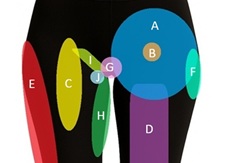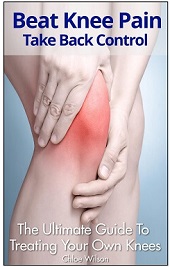- Home
- Hip Pain Diagnosis
- Hip Impingement
Femoroacetabular Impingement (Hip)
Written By: Chloe Wilson, BSc(Hons) Physiotherapy
Reviewed by: KPE Medical Review Board

Femoroacetabular impingement is a common cause of hip and groin pain.
Abnormal bone shape causes excess pressure and friction in the hip joint. This leads to hip pain and restricted movement.
It often affects young and middle-aged adults, particularly athletes or active individuals.
Femoroacetabular impingement is also known as hip impingement, FAI hip or femoral acetabular impingement syndrome (FAIS) . If left untreated, hip impingement syndrome can lead to labral tears and early onset hip arthritis.
Here we will look at what femoral acetabular impingement is, the common causes and symptoms, how it is diagnosis and the best hip impingement treatment options.
What Is Hip Impingement?
Femoroacetabular impingement occurs when the hip bones rub against each other excessively due to being an abnormal shape.
The hip is a ball-and-socket joint formed by:
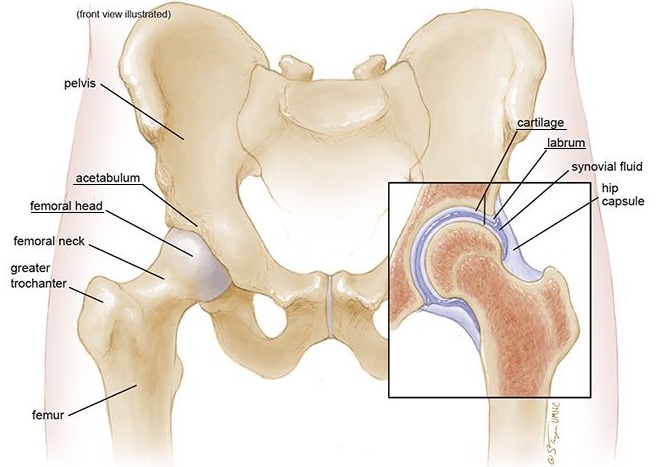
- Femoral Head: The rounded top (ball) of the thigh bone
- Acetabulum: The cup-shaped socket in the pelvis
- Articular Cartilage: Smooth tissue covering the joint surfaces to allow smooth, pain-free movement
- Labrum: A ring of fibrocartilage around the edge of the acetabulum that deepens the socket and stabilizes the joint
With femoroacetabular impingement, variation in the shape of the hip bones causes irregular contact between the femoral head (ball) and the acetabulum (socket).
This can lead to excessive friction, especially during hip flexion, rotation, or twisting activities. Over time, this causes damage to the cartilage and labrum, which gets progressively worse over time.
Types of Hip Impingement
There are three main types of FAI hip depending on which bone is irregularly shaped:
- Cam Impingement Hip: where the femoral head is not perfectly round, but more oval or flattened, which prevents it from rotating smoothly. A bump or “cam” develops on the edge of the femoral head which rubs against the articular cartilage causing damage.
- Pincer Hip Impingement: is caused by extra bone growth extending over the rim of the acetabulum, which can pinch the labrum between the bones during hip motion.
- Combined/Mixed Impingement: Some people present with both pincer and cam deformities, which intensifies symptoms and increases the risk of cartilage damage and labral tears
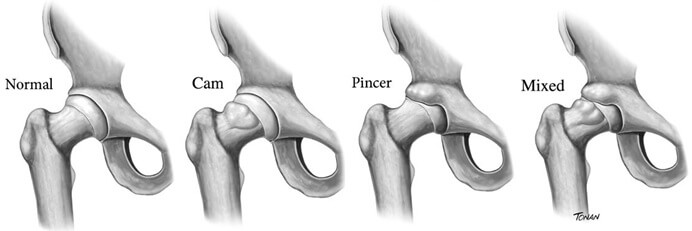
Cam impingement is the most common type of hip impingement, and typically causes symptoms in young men and athletes. Pincer hip impingement is more common in active middle-aged women.
What Causes Hip
Impingement?
Several factors contribute to the development of femoroacetabular impingement:
- Abnormal shape may have been present since birth
- Abnormal bone development in the hip joint during adolescence
- Previous hip injuries or surgeries that alter joint shape
- Genetic predisposition to bone shape irregularities
- Structural issues like hip dysplasia or slipped capital femoral epiphysis that affect joint alignment
- Formation of bone spurs e.g. from hip osteoarthritis
In some cases, the abnormal bone shapes in hip impingement don’t cause any symptoms at all and people live active, pain free lives, often unaware they have femoroacetabular impingement.
However, in others the abnormal bony contact can lead to pain and stiffness. When hip impingement causes pain, it is known as Femoral Acetabular Impingement Syndrome (FAI Syndrome).
With FAI syndrome hip symptoms typically develop in active, sporty individuals whose activities involves lots of repetitive hip movements, especially twisting and squatting e.g. soccer, hockey, martial arts, or dance.
The repetitive movements place ongoing pressure and friction through the articular cartilage and labrum which can lead labral tears or cartilage damage.
Hip Impingement Symptoms
The signs of hip impingement syndrome can vary but typically include:
- Deep, aching pain in the groin or outer hip, especially after prolonged sitting or activity
- Hip stiffness and reduced hip range of motion
- Sharp pain with twisting, squatting, or pivoting movements
- Clicking, catching, or locking sensations in the hip joint
- Referred pain into the buttock or upper thigh
Femoroacetabular impingement symptoms tend to develop gradually, but in some cases, a specific incident may trigger sharp pain.
Femoral acetabular impingement syndrome can develop in the front or back of the hip:
- Anterior Hip Impingement: at the front of the hip is more common and usually occurs during activities involving hip flexion, such as running or sitting.
- Posterior Hip Impingement: at the back of the hip is less common but can cause pain during hip extension or external rotation.
Femoroacetabular impingement is a common cause of top of thigh pain.
Diagnosing FAI Hip Syndrome
Diagnosing femoroacetabular impingement involves a combination of clinical evaluation and imaging:
- Medical History & Physical Exam: The clinician will ask about your symptoms and assess hip mobility, pain location, and history of physical activity or previous injuries.
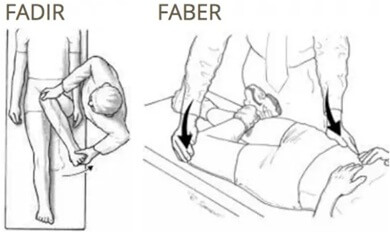
- Hip Impingement Tests: Two common tests for hip impingement are:
- FADIR Test: Hip Flexion, Adduction, Internal Rotation. A common test to reproduce impingement symptoms.
- FABER Test: Hip Flexion, Abduction, External Rotation. Helps distinguish between intra-articular and sacroiliac joint issues.
However, a positive result from these tests can indicate a number of possible hip conditions, not just hip impingement syndrome. - Imaging: Imaging studies are helpful such as
- X-rays help identify cam or pincer lesions and check joint alignment.
- MRI or MRI arthrogram provides detailed views of soft tissues, especially to assess labral tears and cartilage damage.
- CT scans may be used in complex cases to provide 3D imaging of bone structures.
Differential Diagnosis
Other conditions can mimic the signs of hip impingement syndrome and cause front hip pain such as:
- Hip labral tear
- Hip flexor strain
- Groin strain
- Hip flexor tendonitis
- Hip osteoarthritis
- Snapping hip syndrome
- Hip bursitis
- Lumbar disc herniation or nerve compression
Accurate diagnosis is essential to ensure the correct treatment for hip impingement syndrome.
How to Treat Hip Impingement
Femoroacetabular impingement treatment depends on the severity of symptoms and underlying structural problems, but can often be treated without surgery. Conservative hip impingement treatment usually involves:
- Activity Modification: Avoiding positions that aggravate symptoms, such as deep squats or prolonged sitting.
- NSAIDs: Non-Steroidal Anti-Inflammatory Drugs e.g. ibuprofen or naproxen can help reduce inflammation and pain.
- Physiotherapy: Focused on improving hip strength, flexibility, and joint mechanics to offload stress on the impinged area.
- Corticosteroid Injections: Occasionally used to reduce inflammation and confirm the joint as the pain source.
Hip Impingement Exercises
A tailored rehab program for femoroacetabular impingement treatment should include:
- Core Stabilization: Exercises like planks and bird-dogs
- Hip Mobility: Dynamic stretches for hip impingement and controlled joint rotations
- Strengthening Exercises: Such as glute bridges, side-lying leg lifts, resistance band clamshells
- Neuromuscular Re-Education: To improve posture and reduce hip stress during daily activities
Exercise therapy is one of the most important aspects of non-surgical hip impingement treatment and can help delay or avoid surgery.
Hip Impingement Syndrome
Surgery
When conservative management fails to alleviate symptoms or if structural damage is significant, surgery for femoroacetabular impingement may be necessary.
- Hip Arthroscopy: The
most common type of hip impingement syndrome surgery, involving small incisions
and a camera to guide instruments. Surgeons can:
- Reshape the femoral head (cam lesion removal)
- Trim back excessive acetabular rim (pincer lesion correction)
- Repair or remove damaged labrum - Open Surgery: Used in more complex cases or where joint preservation requires more extensive correction.
Hip Impingement Surgery Recovery Time
Around 70–90% of patients report significant pain relief and improved function after hip arthroscopy for FAI
Return to non-sporting activity is typically possible within 3–4 months
Athletes often resume sports within 4–6 months, depending on the extent of the repair and rehabilitation progress
Post-operative rehabilitation is crucial for optimal outcomes and reducing the risk of recurring hip impingement symptoms.
Femoroacetabular Impingement Summary
Femoroacetabular impingement (FAI) syndrome is a key cause of hip pain and movement limitation in active adults. Caused by bone shape abnormalities and aggravated by repetitive motion, hip impingement syndrome can lead to significant discomfort and eventual joint damage if not treated and reduced hip range of motion.
Diagnosis involves specific clinical tests and imaging, while treatment ranges from exercise-based therapy to surgery in more advanced cases. Early recognition and targeted hip impingement treatment can restore function, relieve pain, and help prevent long-term joint issues.
If you're dealing with persistent hip pain, don't ignore the symptoms. Get assessed for FAI hip and take the first step toward recovery.
You may also be interested in the following articles
- Front Hip Pain
- Hip Flexor Pain
- Outer Hip Pain
- Top Of Thigh Pain
- Hip Muscle Anatomy
- Pain Above The Knee
- Knee Clicking & Popping
- Knee Strengthening Exercises
- Hip Stretching Exercises
Related Articles
Hip Strengthening
September 24, 2025
Hip Pain Diagnosis
September 16, 2025
Improve Flexibility
September 30, 2025
Last Updated: September 28th, 2025
Next Review Due: September 28th, 2027

